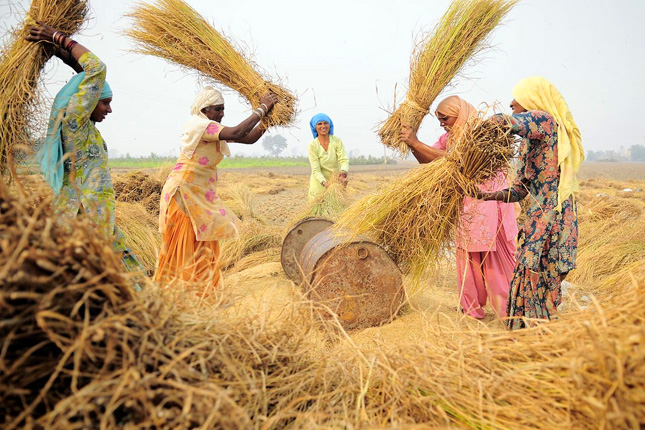-
Are We Headed Toward “Recurring Storms” of Global Food Insecurity?
February 27, 2017 By Erica Martin
It’s often assumed that in the modern era, food security is an achievable goal. But between 2007 and 2008, a confluence of conditions shook the international food system to its core, fueling unrest and riots in more than 40 nations around the world. What’s more, this “perfect storm” may have been only a harbinger of challenges to come, according to a new report by Emmy Simmons of the Center for Strategic and International Studies (CSIS).
“Recurring storms” are likely in the coming years due to ongoing instability in many regions, changing weather patterns, the “double burden” of malnutrition, youthful demographics, food safety issues, and food price volatility, writes Simmons.
The L’Aquila Initiative, a short-lived international response to the 2008 crisis, offers lessons for how to address these underlying trends to improve resilience, but also revealed how difficult the task is.
“Even when national leaders are committed to pursuing market-based, inclusive agricultural growth as a clear pathway to improved food security, and there is relative peace and stability, many risks and uncertainties – storm clouds – loom on the horizon,” writes Simmons.
New and Old Problems
Many of the factors that played into the 2008 perfect storm are still present, writes Simmons. The food crisis stemmed from high food and fuel prices, adverse weather in key agricultural regions, commodity and financial market turmoil, and competition from biofuel production. Looking forward, adverse weather and price volatility will continue to threaten food security, especially in conflict-affected regions, she says.
1.2 to 1.5 billion people live in fragile and conflict-affected statesBut the years since 2008 have also produced new challenges. Climate change will clearly have a significant impact on agriculture, writes Simmons. The growing frequency of extreme weather and natural disasters, like Typhoon Haiyan in the Philippines and recurring droughts in Africa, are the biggest risks to food security in the future, causing volatility in agricultural production.
Conflict has also increased, not decreased, during the last decade. An estimated 1.2 to 1.5 billion people live in fragile and conflict-affected states today. Of the 53 countries facing serious, alarming, or extremely alarming levels of undernutrition on the 2015 Global Hunger Index, only three haven’t been classified as fragile or conflict-affected.
ECSP’s Roger-Mark De Souza called climate change a “threat multiplier” at the launch of the report on February 7 at CSIS. “Climate change drives a set of secondary risks around violent conflict, political instability, population displacement, poverty, and hunger,” he said. It “exacerbates food insecurity and triggers conflict in a multitude of ways.” When there’s competition over scarce resources and high food prices, it’s often marginalized groups and low-income urban populations who are most affected.
Johanna Mendelson Forman, a senior advisor at the Stimson Center and adjunct professor at American University, said she expects current conflicts – many of which are characterized by persistent low-level violence, a “gray zone” of neither full peace nor open warfare – may get worse as urbanization, desertification, demographic pressures, and changes in precipitation compound tensions.
Conflict Zones
The world faces two major issues this century, says Simmons: infrastructure and food security. Both suffer in regions affected by long-running conflict. In Afghanistan, the resurgence of the Taliban in 2014 led to violence that destroyed infrastructure, making it difficult for people to travel for work and disrupting food markets.
“Each situation is unique. Each has its own social, cultural, political, economic, and historical traditions that frame the set of options for peace and conflict recovery,” said Simmons. “But the need to focus on rebuilding food security is common to all.”
The broad food-related challenges faced by post-conflict state can be broken down into five main categories, writes Simmons:
- Governing access to productive resources, especially land and water;
- Getting markets working;
- Advancing rapid and sustained off-farm growth;
- Responding to emerging food security risks and uncertainties; and
- Coordinating international donor support.
The report outlines how these challenges have played out in Afghanistan, Nigeria, and Syria.
In Afghanistan, the many military, humanitarian, and development actors working there have created command-and-control problems and intra-agency tensions. In Nigeria, areas recently liberated from Boko Haram have faced alarming rates of food insecurity, while falling oil prices have led to a depreciation of the currency, driving up food prices and making it difficult for consumers to meet their food needs. For Syria, a severe drought from 2007 to 2010 caused massive population displacement that combined with high levels of unemployment from decreased agricultural production and an oppressive regime to tip the country into violent civil war.
Shining a Spotlight
Looking at past experiences and mistakes shows that more attention needs to be paid to long-term transformative capacity and resilience as opposed to short-term relief efforts, said David Nicholson, senior director of environment, energy, and climate at Mercy Corps.
The report also argues that improved collaboration is needed. There is a “complementarity of skills” among the various humanitarian, development, and military actors who participate in food security efforts, said Forman. However, those communities don’t always speak to each other or among themselves.
“It is essential to renew and expand international collaboration”In response to the 2008 crisis, the G-8 and the G-20 launched the L’Aquila Food Security Initiative, pledging to mobilize at least $20 billion over three years to combat food and agriculture issues around the world. Simmons said the global community needs similar sustained and repeated high-level attention to avert the danger of recurring storms today. The Sustainable Development Goals include food-related targets and may serve as a new rallying point for action, but many post-L’Aquila programs lack inclusiveness, strong leadership, and/or private investment, she said.
Future agriculture programs need to do better at including the poor and most vulnerable to more effectively reduce rural income inequality and food insecurity, writes Simmons. Furthermore, they should encourage a clear public commitment to agricultural development and include coordination and collaboration with the private sector, which plays a crucial role in fostering sustainable growth.
It will take a better balance of effort between stakeholders – political leaders, international food assistance staff, technical leaders, finance ministers, businesses, community leaders, and households – for sustained success. Simmons recommended an annual high-level summit to ensure political attention, review progress, and encourage collaboration.
“Given the magnitude of food insecurity that conflict and political instability cause,” Simmons said at CSIS, “it is essential to renew and expand international collaboration in order to anticipate and prepare for recurring storms of food insecurity in the future.”
Sources: Center for Strategic and International Studies, International Food Policy Research Institute, Peterson Institute for International Economics.
Photo Credit: Rice threshing in Punjab, India, courtesy of Neil Palmer/CIAT. Video: CSIS.
 A Publication of the Stimson Center.
A Publication of the Stimson Center.






